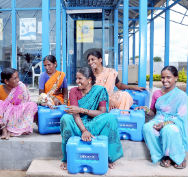P.Venkatesh, a resident of Boduppal village in the southern state of Andhra Pradesh, is a carpenter of modest means. The ever-increasing price of essentials has forced him to cut corners to save each paisa as he struggles to look after his family of four. But despite all odds and after much deliberation, three months ago he decided to make provision for yet another non-negotiable in his monthly budget — drinking water.
At around US$4 a month, water is a “luxury” that Venkatesh must necessarily indulge in. It is a ticket to his family’s continued health and safety. So, each day without fail he takes his jerry can to the WaterHealth Center located close to his house and spends 14 U.S cents to buy 20 liters of its Dr. Water brand of drinking water.
“Earlier, we used the water provided by the gram panchayat [the local self-government]. It wasn’t good for health…. It contains fluorides. I think I have taken a good decision by investing in Dr. Water,” says Venkatesh. A large number of epidemiological studies have indicated that long-term exposure to fluorides from drinking water can lead to several health-related problems, such as decaying teeth and weak bones.
Set up by the U.S.-based WaterHealth International (WHI), the WaterHealth Center is essentially a community water system installation that employs advanced engineering utilizing off-the-shelf technologies, such as UV light disinfection and multi-stage filtration, to remove silt, bad taste and odors. Apart from a water treatment plant, the center includes a small landscaped area for where members of the community can socialize. On average, a water treatment plant measures about 55 square meters and is designed to provide 20 liters of potable water per person, per day, for a community of 3,000 people. A center typically takes around 20 days to set up, and the purified water adheres to the standards of the World Health Organization (WHO).
Pointing out that bottom of the pyramid spending on water is estimated to be US$20.1 billion a year globally, Debapratim Purkayastha, assistant professor at IBS Hyderabad says that WaterHealth “has not only come up with a very innovative offering capable of making a huge social impact, but has also tackled the relevant socio-economic, political, behavioral and communication hurdles. It has positioned itself as one of the few commercial ventures in the safe water section that is primarily focused on underserved and rural populations.” At the other end of the pyramid, well-known bottled water brands like Bisleri and Kinley are priced at US$1.25 for 20 liters.
A Rural Focus
WaterHealth began work in India in 2006 and has so far set up 500 treatment plants across the states of Gujarat, Andhra Pradesh and Karnataka. The capacity of each plant ranges between 1,000 and 3,000 liters per hour (LpH). Most of the plants are located in rural or semi-urban areas. The company currently has a customer base of one million people in the country, but the overall population of the catchment area that it serves comprises five million people.
“Our long-term goal is to set up over 10,000 plants worldwide in the next 10 years and reach 100 million underserved people with affordable water service. India will continue to be a significant part of our network since there is an enormous need and significant room for growth in almost every state,” says Sanjay Bhatnagar, chief executive officer (global) of WHI. Bhatnagar notes that most water service providers offer access to water, but not to “safe water,” hence the significant market potential for solutions like WHI. “Even if 40% of the Indian population is considered to be underserved, it would indicate that over 40,000 decentralized plants could be set up around the country,” he adds.
It hasn’t been an easy journey for WaterHealth in India. The biggest challenge was that of mindset: people were not ready to pay for drinking water. “It was difficult for us to develop acceptability for the model. Back in 2006, we sold 20 liters of water for three U.S. cents. But we moved away from populist pricing and resorted to a price correction,” says Vikas Shah, chief operating officer of WaterHealth India. Shah explains that the team developed a methodology to choose the right site for setting up the plants on the basis of the size of the community, potential user interest and willingness to pay. The organization also did a lot of below-the-line promotions through wall paintings, banners, awareness programs and social marketing.
WaterHealth’s delivery service providers (DSPs) also double up as an effective marketing channel for the organization. Take Jani Kumar of Boddupal village. He has been supplying Dr. Water for the past year to three villages around Boduppal. “In the beginning, I could sell only about 30 cans. Today, I sell 250 cans of 20 liters capacity daily for 16 to 20 U.S. cents each. I have bought two vans and hired four laborers for the business. After taking care of all the overhead [costs], my net income amounts to US$600 each month. I plan to buy another vehicle soon,” notes Kumar, now an independent entrepreneur.
WaterHealth has about 150 DSPs currently in India, up from less than 100 last year. Shah estimates that the number will increase to more than 250 by the end of this year. Earlier, one-third of the company’s sales happened through DSPs and two-thirds over the counter. By the end of this year, DSPs are expected to account for half of the sales.
Decentralized Model
In order to become more accessible to consumers, WaterHealth follows a decentralized model. Instead of big plants with large capacity, it prefers setting up smaller plants at many different locations.
The company has three business models. In the first model, part of the capital expenditures needed to set up the water purification plant is given either by a private donor or contributed by the members of the community. The rest of the funds are raised through a loan from an institutional lender. The loan is repaid over time through the funds generated from the plant operations. After the loan is paid off, the center becomes an income-generating asset for the community. In the second model, WaterHealth funds the entire investment and runs the facility on the build–operate–transfer (BOT) basis. In the third model, WaterHealth sets up the center for a third-party, but manages the operations and maintenance.
Currently, the first model accounts for about 40% of total operations, while the second and third models make up 58% and 2% respectively. Each plant, on average, requires between US$25,000 to US$30,000 as a one-time investment and an additional US$300 to US$350 each month for operating costs. According to Shah, “any plant, irrespective of its size, working at 30% capacity utilization tends to break even.”
Apart from the scheduled preventive and repair maintenance, WaterHealth also conducts periodic quality audits. Water samples are taken every day from the production lot and stored for analysis. Water-quality tests are conducted at each center to ensure that the water meets or exceeds the WHO standards.
Acumen Fund, a nonprofit venture capital fund, made an equity investment of US$600,000 in WHI in 2004. It followed it up with a US$290,000 loan guarantee in 2006 and another loan guarantee of US$1.3 million in 2008. Two additional rounds of equity infusions by Acumen of US$320,000 (2008) and US$1 million (2009) have come in since. In her book The Blue Sweater: Bridging the Gap between Rich and Poor in an Interconnected World, Acumen Fund founder Jacqueline Novogratz, recalled how providing a loan guarantee helped bring in bank credit to rural India: “We could have lent directly for village operations, but this approach would bring more money into underserved areas. Over time, we reasoned, if the business model worked, the banks would become more comfortable with lending and we could reduce our guarantee. As it turned out, in less than a year, because of WHI’s track record, Acumen was able to provide a second guarantee with 15% loss coverage…. A US$1 million guarantee from Acumen released US$8 million in commercial loans to build rural water systems.”
According to Sameer Mithal, executive vice president of global business development at WHI, the company has so far invested about US$20 million in its India operations. “Fundraising is not an issue for businesses that are solving a need and have a scalable business model, especially for emerging and developing markets,” Mithal notes. “We are focused on growing our business and running it efficiently.” Currently, WHI’s footprint extends across India, Bangladesh, the Philippines and West Africa. It is already evaluating needs and opportunities in other parts of the world, including the U.S., Latin America and several Asian countries.
Market Potential
Like WaterHealth, there are other innovative, low-cost models that are seeking to address the need for safe drinking water among the economically weaker sections in India. For instance, Swach and Pureit water purifiers, from the Tatas and Hindustan Unilever respectively, are retail offerings. Unlike most other water purifiers in the market, these do not require running water or electricity. Spring Health, a subsidiary of U.S.-based Windhorse International, builds water tanks near village shops. Spring Health employees travel by motorcycles to different villages to purify water tanks with liquid chlorine and the water is tested before being sold. The company has a presence in 20 villages of the Khurda, Jajpur, Puri and Dhenkanal districts in India’s eastern state of Orissa and sells water at 0.4 U.S. cents a liter.
But for now, WaterHealth does not really have to worry about competition. The demand for safe drinking water in India is simply too huge. According to the 2011 census, over 50% of households in India don’t have access to drinking water in their homes. A recent report released by UNICEF and the WHO estimates that 97 million people in India don’t have access to an acceptable drinking water source.
Purkayastha of IBS Hyderabad suggests that one of the key success factors of WaterHealth is its adaptability. He points out that globally, the company was founded in 1996 with UV water systems. However it was unable to break even. “By 2002, the company had made investments of around US$6 million, but was able to sell only 300 units at a price of US$1,000 each.” It then decided to adopt a new approach to market its technology. WHI partnered with several NGOs to educate rural consumers about the significance of drinking clean water. A financing structure was also set up that enabled the communities to make a down payment of around 30% to 40%, with the rest of the amount being paid through a loan arranged by WaterHealth.
“After trying to sell the water system as a product with limited success, they decided to sell it as a service and built a comprehensive business model around it,” says Purkayastha. “WaterHealth’s revenue model is robust enough to not only cover all costs associated with manufacturing, marketing and distributing its products or services, but also to generate a profit. Thus, it has not had to depend on donor funds and that has added to its sustainability.”



